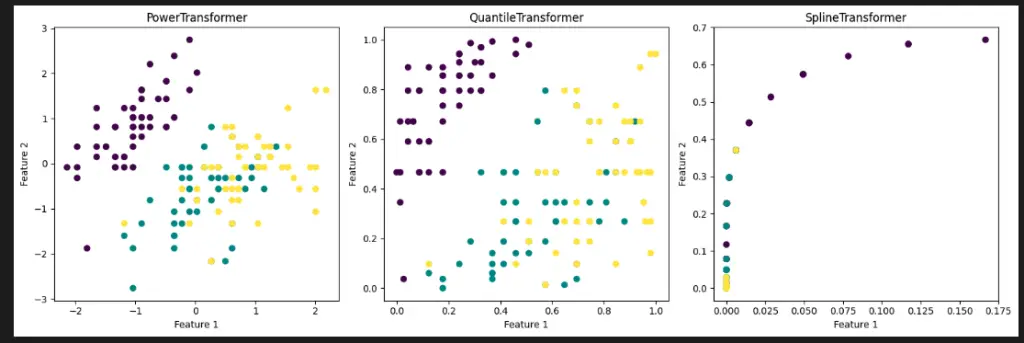Machine learning relies heavily on data preprocessing to ensure accurate and reliable model performance. Scikit-Learn provides a powerful set of preprocessing transformers to manipulate and transform your data before feeding it into machine learning algorithms. In this article, we’ll explore some important preprocessing transformers in Scikit-Learn.

PowerTransformer
What is PowerTransformer?
PowerTransformer is a preprocessing transformer that applies power transformations to make data more Gaussian-like, which can improve the performance of certain machine learning algorithms.
Why Use PowerTransformer?
- Corrects skewed distributions and reduces the impact of outliers.
- Enhances the performance of algorithms that assume Gaussian distribution.
QuantileTransformer
What is QuantileTransformer?
QuantileTransformer is a preprocessing transformer that transforms features to have a uniform or Gaussian distribution.
Why Use QuantileTransformer?
- Helps normalize features and improve model performance.
- Can be useful when dealing with non-normal data distributions.
SplineTransformer
What is SplineTransformer?
SplineTransformer is a preprocessing transformer that applies cubic spline interpolation to transform features.
Why Use SplineTransformer?
- Can be effective when dealing with non-linear relationships between features.
- Helps capture complex interactions and patterns in the data.
Comparison: PowerTransformer vs. QuantileTransformer vs. SplineTransformer
PowerTransformer vs. QuantileTransformer:
- PowerTransformer aims to make data more Gaussian-like, while QuantileTransformer aims to normalize features.
- PowerTransformer is sensitive to outliers, whereas QuantileTransformer is less sensitive due to rank-based transformation.
QuantileTransformer vs. SplineTransformer:
- QuantileTransformer focuses on reshaping the distribution of features, while SplineTransformer captures non-linear relationships.
- SplineTransformer may be more appropriate when non-linearities are present in the data.
Python Example with Sklearn Transformers
import numpy as np
import matplotlib.pyplot as plt
from sklearn.datasets import load_iris
from sklearn.preprocessing import PowerTransformer, QuantileTransformer, SplineTransformer
# Load a dataset (for example, the Iris dataset)
iris = load_iris()
X = iris.data
# Initialize instances of the transformers:
power_transformer = PowerTransformer()
quantile_transformer = QuantileTransformer()
spline_transformer = SplineTransformer()
# Fit and transform the data using each transformer
X_power = power_transformer.fit_transform(X)
X_quantile = quantile_transformer.fit_transform(X)
X_spline = spline_transformer.fit_transform(X)
fig, axes = plt.subplots(1, 3, figsize=(15, 5))
# Plot using PowerTransformer
axes[0].scatter(X_power[:, 0], X_power[:, 1], c=iris.target)
axes[0].set_title("PowerTransformer")
axes[0].set_xlabel("Feature 1")
axes[0].set_ylabel("Feature 2")
# Plot using QuantileTransformer
axes[1].scatter(X_quantile[:, 0], X_quantile[:, 1], c=iris.target)
axes[1].set_title("QuantileTransformer")
axes[1].set_xlabel("Feature 1")
axes[1].set_ylabel("Feature 2")
# Plot using SplineTransformer
axes[2].scatter(X_spline[:, 0], X_spline[:, 1], c=iris.target)
axes[2].set_title("SplineTransformer")
axes[2].set_xlabel("Feature 1")
axes[2].set_ylabel("Feature 2")
plt.tight_layout()
plt.show()

Relevant entities
| Entity | Properties |
|---|---|
PowerTransformer | Applies power transformations to make data more Gaussian-like. |
QuantileTransformer | Transforms features to have a uniform or Gaussian distribution. |
SplineTransformer | Applies cubic spline interpolation to transform features. |
Conclusion
Scikit-Learn preprocessing transformers provide essential tools to preprocess and transform data before using it for machine learning tasks. Whether you need to handle skewed data, normalize distributions, or capture non-linear relationships, Scikit-Learn has a variety of transformers to suit your needs. By applying the right preprocessing techniques, you can enhance the performance and reliability of your machine learning models.

